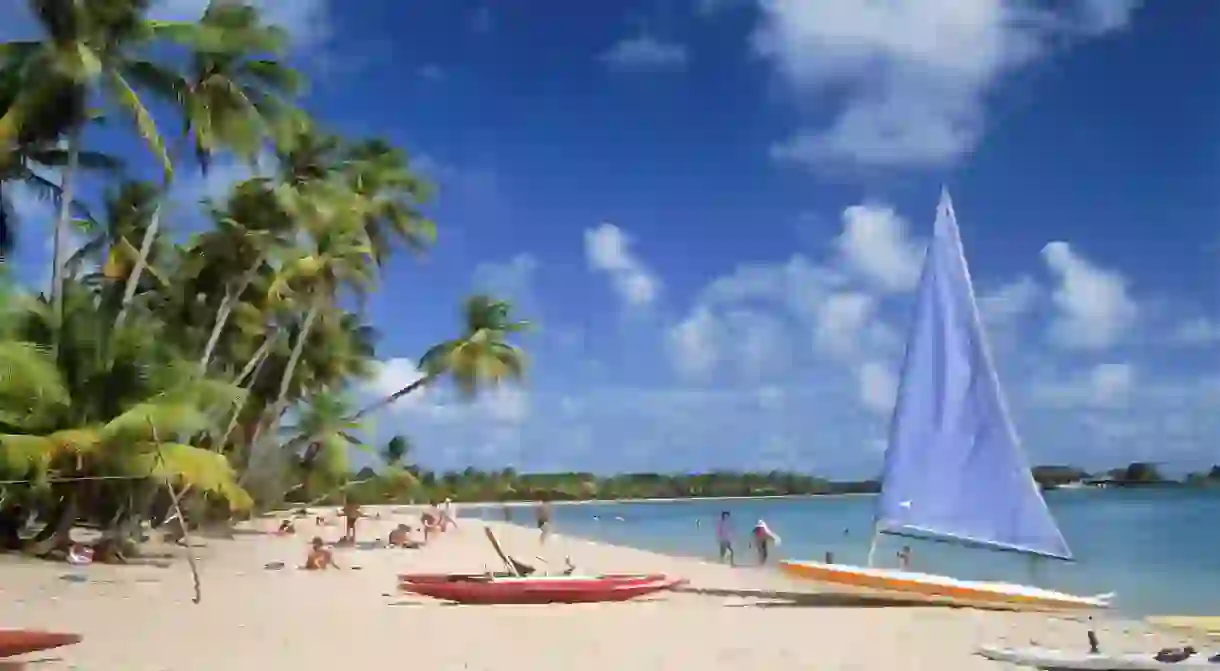A First-Time Traveler's Guide to Martinique

Martinique — Saint Lucia’s overlooked sister island— is a captivating combination of deep rainforest, rocky cliffside terrain, Creole-inspired cuisine, and the calmest, clearest water you’ll ever encounter. The French Caribbean island is over 430sqkm (166sqkm) of rugged paradise that is best explored by car, as each corner of the isle has something spectacular to offer. Go trekking in the north, kayaking in the west, and surfing in the east, all the while eating fancy cheese or freshly-caught fish alongside a refreshing rum punch.
The blend of French and West Indian cultures have created a unique island that is raw and untouched, while also catering to the affluent French tourists that vacation to Martinique once a year. Keep in mind: having a basic French vocabulary will go a long way on this secluded island.
Where to stay
Hotel Bakoua – Les Trois-Ilets
The sultry resort area of Pointe du Bout in Les Trois-Ilets sits just across the bay from Fort-de-France, the island’s capital city. Complete with beachfront accommodation, an infinity pool, and four restaurants and bars, the Creole-designed Hotel Bakoua is frequented by first-time travelers and yearly visitors alike.
A main hotel attraction is Le Coco Bar, a small, informal hut resting on stilts above the still bay water. Numerous boat trips leave from the Pointe de Bout Marina and include activities like dolphin-watching, fishing and snorkeling. The wood-furnished rooms start at €115 a night and are each equipped with their own balcony.

Rent an Airbnb
Though many travelers prefer accommodation in the form of hotels, on an island like Martinique — where local tips are key — an Airbnb will take you a long way. With over 300 rentals, ranging from low-key to luxury, you’ll soon realize how far your money goes in Martinique.
Le Diamant is a southeastern town and is home to the island’s longest beach. The luxe Caribbean House on the Sea is a three-bedroom, cliffside haven in this charming town, and overlooks the Marigot Cove (and it’ll cost you a mere $23 USD per person). A little further in the town of Le Marin you’ll find the chic Villa Passe Mon Temps, where $50 USD per person will get you ocean views, an outdoor deck and pool, and two gorgeous poolside bedrooms.
What to eat
Dine at Le Fromager
After a 30-minute climb up the winding road from Saint-Pierre, you’re met with Le Fromager to your left: an unassuming, red-roofed restaurant perched atop a cliff. Decorated with wooden tables and chairs, the open-aired space overlooks Turin Cove and the rooftops of the alluring Saint-Pierre. Just as enticing, however, is the inexpensive and appetizing Creole menu. Feast on a fresh vivaneau (red snapper) or local lambi (queen conch) while sipping on a refreshing tropical juice. Visit on a Sunday afternoon, when a casual lunch will turn into a local celebration complete with live music, dancing and delicious Martinique food.

Don’t overlook the roadside vendors
Although there are the “must-go” spots to dine (we are talking about the French Caribbean, after all), Martinique trips are made even better by the street side carts and local eateries. Order the island specialty of grilled fish with steamed rice and ratatouille (or fresh salad) or Poulet Boucane (smoked chicken). Averaging at around €8, these dishes are large enough to feed two and will have you wishing you’d started eating roadside long ago.

What to do
Hike the Caravelle Peninsula (Presqu’ile de la Caravelle)
A common local pastime is hiking the jagged terrain of the Caravelle Peninsula. Set along the water’s edge, the headland provides multiple routes and loops. The waves crash against the wild rocks, misting your skin with a welcoming chill. The midday sun seeps through your clothes as you anticipate the next shaded section of the path. As you near your relief, and a casual walk turns into a four-hour trek, you discern voices close by. The trees part and there is au trou cochon: the national park’s watering hole. Literally translating to “pig hole,” this small, covert hangout is scattered with locals spending a lazy Sunday sitting in the unruffled water, sipping on glasses of rose.
Visit the Anse Cafard Slave Memorial
Perched atop Cafard Cove, the slave memorial pays homage to the ship full of slaves that collided with the cliffs of Le Diamant on April 8th, 1830. The group of 15 stone men face the Caribbean Sea and bow their heads in respect, acknowledging the deaths and suffering that occurred at 11pm when crashing and cries shattered the silence of the night. Visiting this outdoor memorial acknowledges an important piece of Martinique’s history, while also providing impressive views over the rough waters of Le Diamant beach.

Lay back on the beaches: Anse Noir and Anse Dufour
On the southwest of the island these two beaches can be found directly beside one another. So what is so unique about these Caribbean coves? Besides being known as a spectacular snorkeling spot (you’re likely to spot a turtle or two), Anse Noir is also recognized for its jet black sand; a highlight of many Martinique trips.
The contrast of the black sand, Tanqueray-green water, and surrounding bold greenery, makes “Black Cove” a truly charming sight. Just a few minute’s walk around the bay will lead you to Anse Noir’s white-sand sister beach, Anse Dufour. Palm trees and local food shacks adorn the small cove while locals fill the transparent water, throwing a frisbee or just passing time.














